Crash Story File: The Reme Baca Smoking-Gun Interview

By Douglas Dean Johnson
@ddeanjohnson on X/Twitter
Original publication: May 20, 2023. All substantive changes or updates after that date are summarized in a log that appears at the end of the article. Most recent update: March 12, 2025. Note: I made a very significant "Key Update" on January 29, 2025, based on shockingly deceptive statements made by Jacques Vallee in the Third Edition of "Trinity: The Best-Kept Secret." This update appears near the bottom of the section headed "What Should Jacques Vallee Do Now?"
***
Less than a year before going public with what became the Jacques Vallee-Paola Harris story of the 1945 crash of an avocado-shaped UFO, Reme Baca was tape-recorded peddling a very different story about a boyhood encounter that he and Jose Padilla had with a very different sort of UFO: a tale of their discovery of a classical flying saucer, crashed– in 1946. And that's just the start.
You are in the Crash Story Files, a series of investigative reports examining claims that a UFO crashed and was recovered near San Antonio, New Mexico, in August 1945. These claims were given wide circulation by the book Trinity: The Best-Kept Secret, by Jacques Vallee and Paola Harris (2021, 2022). To go to the Crash Story hub story, The Trinity UFO Crash Hoax (May 1, 2023), which contains an index to the complete series of Crash Story Files, click here.
(May 20, 2023) Less than a year before Remigio (Reme) Baca and Joseph Lopez (Jose) Padilla first went public with their story of witnessing a UFO crash and recovery as young boys, in New Mexico in August 1945, Reme Baca tried to interest a well-known writer of popular works on the Roswell Incident, Thomas J. Carey, in an eyewitness account of Baca and Padilla encountering a crashed UFO when they were boys.
But in a revelation that will shock many, the "eyewitness" account that Reme Baca presented to Thomas J. Carey—who audio-recorded it—was very different from the UFO-crash story that Baca and Padilla presented to the public less than one year later. That later public version has reached large audiences in recent years, due mainly its promotion by the book Trinity: The Best-Kept Secret, by Jacques Vallee and Paola Harris (First Edition June 2021; Second Edition August 2022).
In retrospect, it appears that what Baca presented to Carey was what might be regarded an unsuccessful first draft of the hoax tale. After Carey failed to take the bait (which followed earlier such failures by Baca), Baca clearly made extensive revisions in his script, producing a more complex and interesting story. In the revised story, key characters went forth with a different purpose, in a different year, encountered very different situations, and did very different things than in the version that Carey recorded. It is only the extensively revamped version that the public has ever heard, beginning in late 2003.
To summarize what is documented below, and in the embedded primary source material: In the narrative offered by Baca to Carey, the boys set off one summer day in 1946 (yes, 1946, not 1945), in a pickup truck (not on horses), to visit Ground Zero (!). Quite unexpectedly (no predicate unusual sounds or lights are reported), they come upon a big disk (not an "avocado") on the ground, with a hole in it, and glimpse some entities that look "like bugs." They return the next day with Padilla's father and a State Police officer, but somebody has covered up the disk with dirt, so the State Police officer turns and leaves without even glimpsing the craft. In subsequent days, young soldiers load debris onto "trailers." One night the two boys sneak onto one of the trailers, at a location specifically stated not to be the crash site, and remove the artifact that figures prominently in the later public version of the story. In his account to Carey, Baca never describes any human entering the disk.
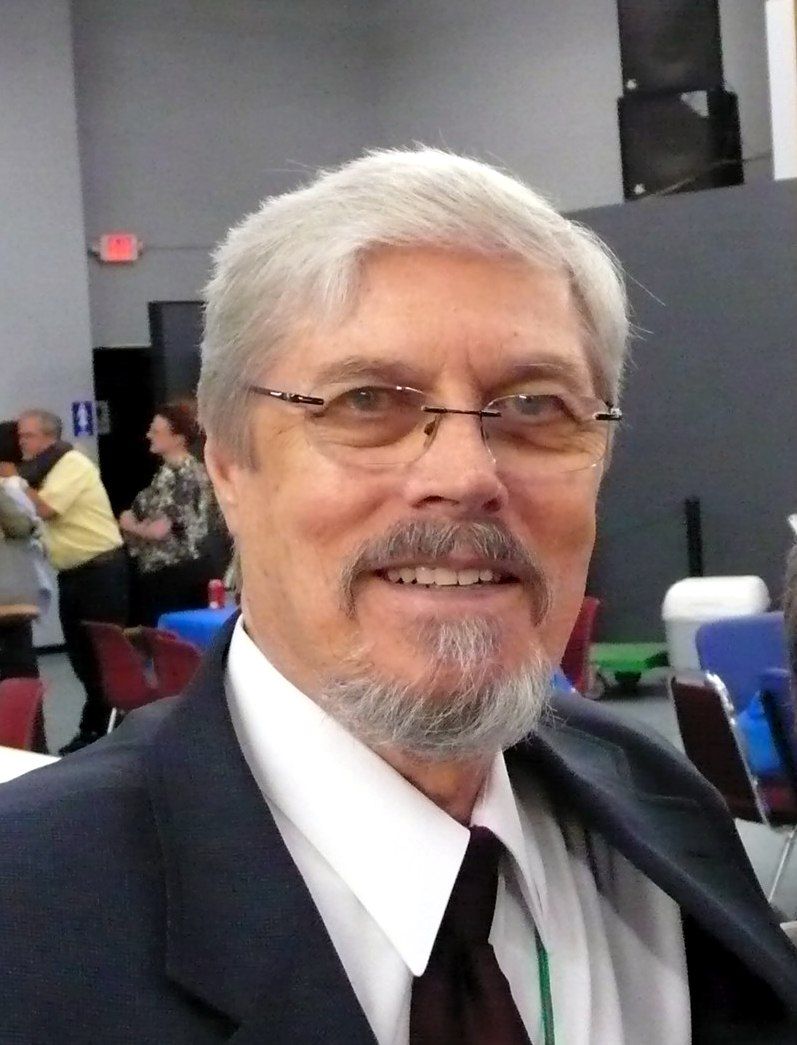
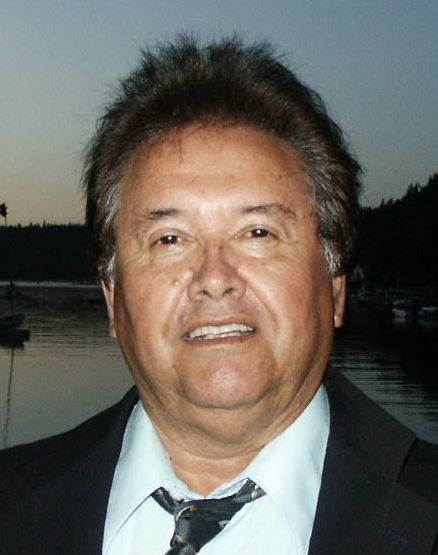
Roswell Incident researcher-writer Thomas J. Carey (top or left). Trinity UFO Crash hoaxer Remigio (Reme) Baca (bottom or right).
The first publication anywhere of the public version of the Baca-Padilla UFO-crash story was in a two-part series written by Ben Moffett, which appeared in the October 30 and November 6, 2003 editions of the weekly newspaper The Mountain Mail of Socorro County, New Mexico. In 2015, Moffett wrote that he relied entirely on what Baca and Padilla told him, used “no other sources," and "was never comfortable with many of Baca's assertions." Baca died in 2013. Moffett died in 2019. Padilla is still alive, age 86.
The interview of Reme Baca by Tom Carey occurred very late in 2002 or early in 2003– at most, 11 months before Ben Moffett's two stories were published. The contents of the Carey interview were long forgotten, the cassette itself stored among recordings of hundreds of interviews that Carey has conducted. The detailed contents of the interview are being publicly reported here for the first time anywhere, as part of my ongoing investigation into the origins and claims of the Trinity UFO crash tale.
[I recommend that those with interest in this hoax also familiarize themselves with the suite of articles that I published on May 1, 2023, the Crash Story Files (the hub article and index are here.), and with more recent articles as well – but this article that you are reading contains sufficient contextual information to stand on its own. As I argue below, Carey’s recorded interview with Reme Baca by itself constitutes proof beyond a reasonable doubt that the entire Baca-Padilla tale of a UFO crash at San Antonio, New Mexico, is a hoax to its core.]
After searching out and reviewing the long-forgotten cassette recording at my request, on May 8, 2023, Carey lent it to me. I had the recording professionally converted into a digital audio file, with noise reduced and volume boosted, but absolutely no editing or deletion of any content. That complete 30-minute audio file is embedded below in the .mp3 format, both in a high-resolution file (29 mb) and in a lower-resolution file of e-mailable size (7 mb). I have also embedded below a complete, validated-by-ear, time-stamped transcript in PDF format.
If you have any difficulty with the embedded .mp3 audio files below, you can also download the high-resolution version of the interview (29 mb) from this link, or the lower-resolution version (7 mb) from this link.
Carey has explained to me that Reme Baca called him, and that Baca gave permission – indeed, was eager-- for the conversation to be recorded. Baca’s purpose was to get Carey, a widely read writer on the Roswell Incident, to study and publicize Baca’s story. Baca already had tried and failed to interest other prominent UFO-themed writers in his "personal" story, including Stanton Friedman (1934-2019).
The recording began with Carey asking Baca how he had obtained Carey's phone number. Baca referred to a newspaper article. Carey speculated that it was likely an article resulting from a recent special Sci Fi Channel program about the Roswell incident, The Roswell Crash: Startling New Evidence, for which Carey had been both a consultant and an interviewee. The program – the highest-rated original show that the channel had ever produced, drawing 1.5 million viewing households --was broadcast on November 22, 2002. This establishes that the Carey-Baca conversation occurred after that date--but it could not have been very long after, because the first Ben Moffett article appeared on October 30, 2003, and there had been at least two cycles of back-and-forth communication between Moffett and the two tale-tellers before Moffett's articles appeared. (Moffett died in 2019.) Moreover, on the Carey recording, Carey and Baca seem to be discussing the Sci Fi Channel program as a recent event.
Baca proceeded to narrate to Carey an extraordinary encounter that Baca and his “cousin” Jose had experienced as boys living near San Antonio, New Mexico. The incident occurred, he said, on land controlled by Jose’s family--thereby clearly establishing that the “Jose” or "Joe" referred to was indeed Joseph Lopez (Jose) Padilla, even though Baca did not verbalize Jose's last name in the recorded conversation. During the conversation, Baca referred multiple times to Jose, and indicated that Jose would be willing to speak to Carey and Carey's research associate if they came to the west coast (Carey lives in Pennsylvania, and Baca at this time lived in Washington State). Baca's presentation leaves little room for doubt that he and Padilla were working in concert on the crash-story project.
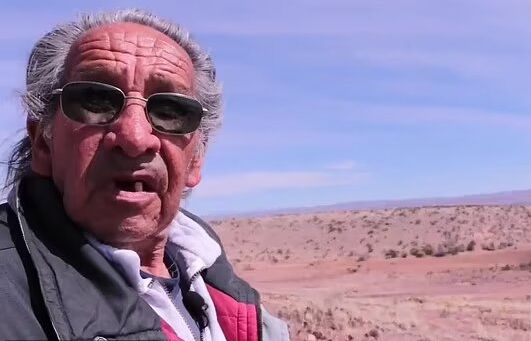
Here is a summary of some (but not nearly all) of the divergences between the "eyewitness" accounts that Reme Baca told Tom Carey, and the later public Baca-Padilla-Harris-Vallee story (see also the table bel0w):
(1) Baca told Carey four times that the boyhood encounter occurred in the summer of 1946 (“1946, because it’d been about a year since the bomb,” Baca said), probably “in August.” [Timestamps: 11:08, 11:13, 18:55, 30:10-30:16] In the version of Baca-Padilla tale widely publicized by Vallee and Harris, the two boys heard and arrived at a just-crashed UFO one month after the atomic test—on August 16, 1945, according to Trinity: The Best-Kept Secret.
(2) Baca told Carey that the two boys set out that day to visit “Ground Zero,” the exact spot where the first atomic bomb had been detonated about a year earlier: “We decided that we wanted to go out and look for that...for the Ground Zero.” [Timestamp: 5:47] "We wanted some of that green stuff," Baca explained, apparently referring to trinitite, a fragmented green glassy substance produced by the atomic blast, which for some years people picked up at the site as curiosities. The boys also had a legitimate justification to go that direction, Baca said: To look for a lost cow who was expected to calve. No plan to visit Ground Zero (!) has ever been mentioned in the later public Baca-Padilla-Vallee-Harris tale—which, after all, was set on a date only four weeks after the blast. In the public story, the boys were merely looking for the cow, and checking fences.
(3) Baca told Carey that the boys drove towards their distant goal in a pickup truck. (“In fact, we went on his [Padilla’s] pickup truck...his dad’s pickup truck.”) [Timestamp: 5:54] In the later public version of the tale, the boys rode horses on the excursion to look for the cow and to fix fences.
(4) Baca told Carey that after finding the cow and newborn calf, the boys continued towards their goal (Ground Zero), but “we never got there,” because in a canyon “we walked down and there’s this great big round thing.” [Timestamp: 6:36] To Carey, Baca made no claim at all that the boys heard or saw or heard anything unusual until that moment of discovery--rather, they simply came across a large disc, with a hole in it, sitting on the ground. “It had not been there very long, because some of the brush was burnt,” Baca said. In the later public versions of the story, the boys heard a tremendous sound and/or saw a bright flash of light as the UFO crashed, after which they crossed a ridge and saw the just-crashed craft (amidst burning creosote trees, in most tellings, although Padilla made contradictory assertions, in different interviews years apart, that there was and was not a fire).
(5) In the story Baca told to Carey, the boys “see some shadowy figures inside,” that Baca said looked like “bugs" or "ants," but he offered few details; he said nothing about unusual movements by the "bugs," nor reported them making any sounds. In their public narrations beginning in October 2003, Baca and Padilla offered considerably detailed (and sometimes blatantly conflicting) descriptions of the aliens they said they saw in August, 1945 – Padilla said, for example, that they had "four fingers" – and added other details such as unusual movements ("they moved fast, as if they were able to will themselves from one position to another") and squeals like a jackrabbit in distress.
(6) In Baca’s story to Carey, the two boys returned the next day with Padilla’s father (in the public story, it was two days later). On this return visit, Baca told Carey that the two boys were accompanied by a member of the State Police, whom he did not name. But the craft was not initially visible because “somebody had thrown dirt all over the top of it, so you couldn’t see it from the top of the hill...,” so the State Police officer simply left without ever seeing the craft. (“He was up on the top of the hill. And so when we couldn’t see anything when we looked down there-- you know, you couldn't see it-- then he left.” [Timestamp: 10:32]) In the public story, the policeman was identified specifically as New Mexico State Police Officer Eddie Apodaca, a “friend of the [Padilla] family," and he entered the alien craft along with Padilla’s father, as Reme Baca and Jose Padilla watched from a distance.
(7) Baca told Carey that in subsequent days, young soldiers (“Young kids, you know?”) loaded trailers (multiple) with material from the crash site, but would then would go to town to socialize with local females, leaving the debris-laden trailers unattended. “At night is when they move that stuff, and they'd go in there and load up their trailers, then they leave them there [at the crash site]. And then they'd take one truck and they'd go over to the bar, to the old cafe.” [Timestamp: 14:59.] Baca told Carey: “Anyway, what we did one of the times is we went into one of their trailers and took a piece off there. Which was way different than anything that was on the outside [of the craft]...” [Timestamp: 16:07.] Carey asked, “So you got it from one of the trucks?" Baca answers, "Yeah! We did." Carey asks, "Rather than at the crash site?” Baca answers, “That's right.” [Timestamps: 26:27 through 26:54.] In the public version of the story, Padilla entered the alien craft, still at the crash site but secured to a frame on a big flatbed truck, and then uses all his strength and a tool to pry the artifact off its fastenings to the inner wall panel of the alien craft. Baca later mailed photos of the object taken off the "trailer" to Carey, who preserved one of them as a scanned image; it is shown further down. While the image does not show the entire object, it certainly appears to be the same object that, in the public story, Jose Padilla claimed to have pried off the interior wall panel of the crashed alien ship.
(8) In Baca’s story to Carey, there was no mention of any human seen entering the alien craft, on any day. In the later public story, Jose’s father Faustino and New Mexico State Police Officer Eddie Apodaca, and later Jose Padilla, all entered the craft.
(9) Baca told Carey the downed craft was “a disk” about 35 or 40 feet across and 5 feet deep. [Timestamps: 29:20 through 29:32.] Baca also said “what I remember is there was like maybe big, lights underneath.” [Timestamp: 9:48.] In the public story, the craft was described in somewhat inconsistent ways, but most often as shaped like an avocado, with the bottom (described in conflicting ways, but never with lights) not visible until after it was lifted onto an Army truck. Baca and Padilla said they had "stepped off" the craft's length as 25-30 feet wide, and estimated its height as 14 feet. On various occasions, Vallee and Harris have gone out of their way to cite the craft's unconventional shape: "What they describe...was not a disk or a 'flying saucer' at all. It was, as Jose puts it, something resembling the shape of a flattened avocado, 25 feel long (plus or minus five feet...)" – Trinity: The Best-Kept Secret, Second Edition, p. 155.
So then, to summarize major elements of the tale told by Reme Baca to Tom Carey in late 2002 or early 2003: In the summer of 1946 (probably August), about a year after the first atom bomb test of July 1945, Reme and Jose set off in a pickup truck to visit Ground Zero (at least 25 miles away, probably more like 30 miles). Without warning, they suddenly came across a large crashed disk. The only other specific person named as a witness to the downed craft was Padilla’s father, who visited the site on the day after the discovery (a State Police officer came along, but he left without laying eyes on the craft). Baca never mentioned anybody entering the craft on any day. Some days later, the boys swiped a metal artifact off the back of an unattended military trailer, at some location other than the crash site.
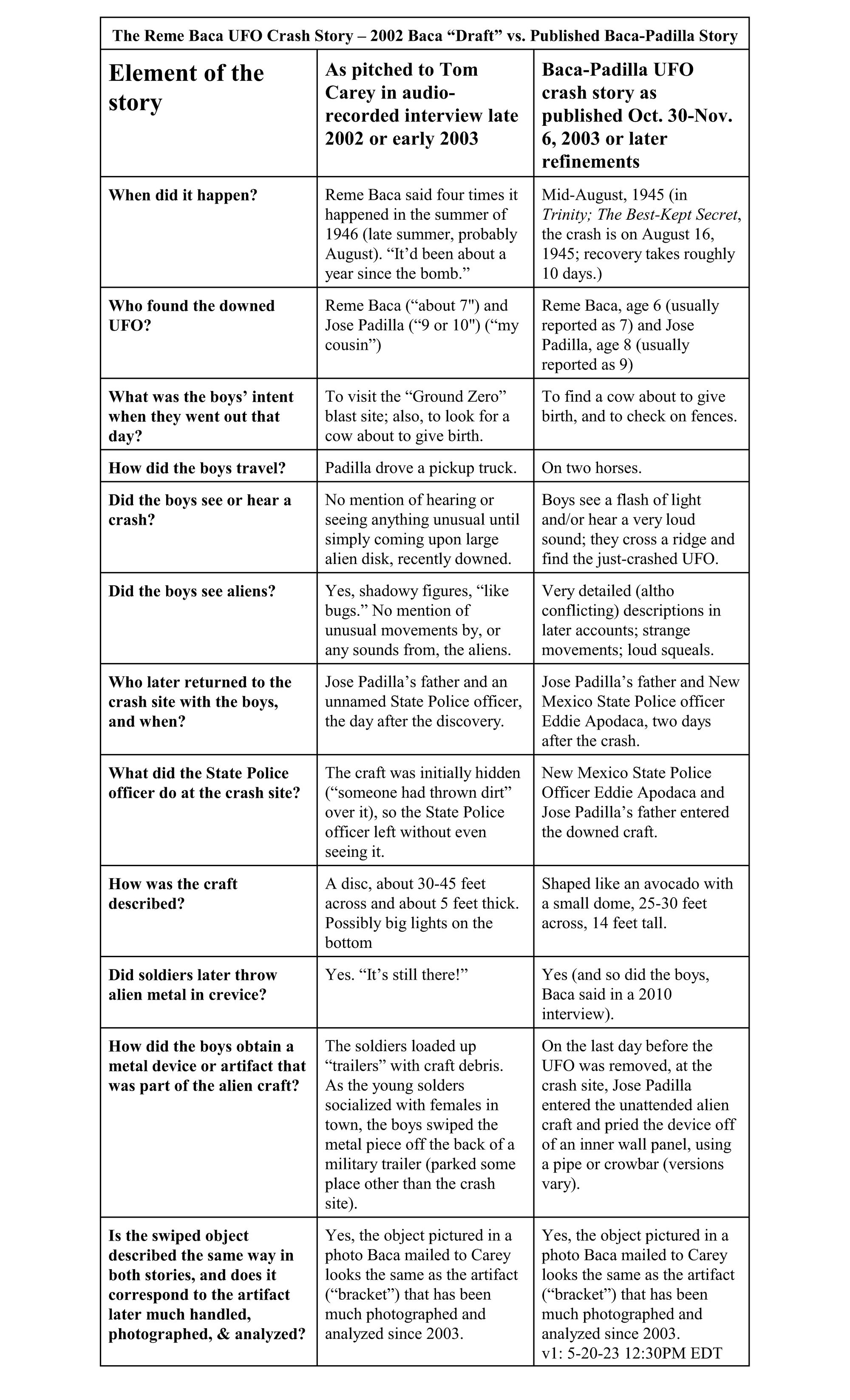
[The side-by-side comparison shown above is embedded below as a PDF document.
BACA TRIES TO SELL CAREY ON THE STORY--WITHOUT SUCCESS
During the interview, Baca said twice in quick succession, “This is before Roswell,” seemingly eager to impress that particular point on Carey. [Timestamps: 11:02, 11:13.] The “before Roswell” line later became a theme of Paola Harris and others in their promotion of the public, 1945-crash version of the story.
During the conversation, Baca referred several times to television programs about various purported UFO crashes, including one story that he tried to tie to his purported childhood experience. Carey made minimal responses to those comments, repeatedly bringing Baca back to details of what Baca had seen, the order of events, the characteristics of the metal artifact, and other such matters.
Baca seemed particularly keen to play up the significance of the metallic artifact that he said the boys had swiped off a military trailer. “We still have it. We are probably the only people in the United States that have an alien artifact,” Baca said. [Timestamp: 17:27.] Baca claimed that the object was "colder than hell" and that "it emits cold." [Timestamps: 18:13, 18:31.]
(Before his death in 2013, Baca made unsuccessful attempts to sell the metal artifact for a large sum – reported by more than one source as over $200,000, but I was unable to obtain documentary proof. Baca’s efforts may have failed in part because multiple analyses have revealed the object to be composed of a commonplace terrestrial aluminum alloy, manufactured by prosaic methods to metric dimensions. See my Crash Story File: The ‘Alien’ Artifact with Metric Dimensions. In a video taken in 2014, Mexican ufologist Jaime Maussan is seen holding the artifact and remarking to Jose Padilla, "This is very important. You took this from a UFO. I think it is very valuable." Maussan asked Padilla what he intended to do with the artifact, to which Padilla responded that he thought he would place it with a museum. Maussan then said to Padilla, "Reme wanted a lot of money to present this [artifact], but you don't -- why?" Padilla answered, "Money is not important to me. It's just the principle."]
[UPDATE: In a presentation on the internet on September 16, 2023, Paola Harris said, "Reme Bacca was pretty greedy. He wanted $250,000 for the piece [the aluminum bracket], and he wanted $250,000 for the story. And he doesn't know you can't copyright a story when it's in the public domain....He was going to sell the piece. It wasn't even his piece. He didn't even pick it. He didn't even take it out. It was Jose that took it out." Baca's arduous attempts to sell the story and the bracket went unmentioned in Trinity: The Best-Kept Secret, and were also publicly unmentioned by Vallee, until after the publication of my first series of Trinity-related articles on May 1, 2023.]
In addition, Baca told Carey, near the end of the recording, that soldiers put “some of that [alien debris] material” in a crevice “and then they put dirt and rocks on it. They’re still there!” This claim of buried alien metal became the focus of years of effort by Baca and Padilla to raise substantial funds to excavate the site--efforts that I have documented in Crash Story File: Waiting for a Payday. I have found no indication that their persistent solicitations for a big excavation project ever met with success, but it was not for want of trying.
Baca also spoke to Carey of recovering a flexible piece of metal that would unfold into its original shape, but he said he had used it long ago to repair a now-departed windmill. Baca made passing reference to having picked up material that he compared in appearance to Christmas tree decorations used in his childhood called "angel hair" (this term in the 1950s referred to an elongated material made of fiberglass or spun glass, used as a decoration). Carey did not engage on those claims, focusing his interest on the single artifact that Baca said that he still possessed. Stories about past possession of materials displaying exotic attributes (but alas! no longer available for analysis) were retained in the later public version of the Baca-Padilla tale.
Aside from those key talking points, however, Baca's recitation of his purported childhood experience story was rather flat. Although he three times said the phrase, "We were scared as hell," the narrative otherwise was lacking in expressions of emotion or much in the way of dialog. [Timestamps: 6:36 and 7:45.]
The recorded part of the conversation ended after 30 minutes, when the A side of the tape cassette reached its end. One of the last Baca statements recorded was, “I talked to Paul Davids (about it) and he says, ‘you know, if you ever get anything together, that’s another movie.” Paul Davids was the producer of a made-for-television (Showtime) movie titled Roswell: The UFO Cover-up, which was a dramatization of the experiences of Major Jesse Marcel, a key figure in the Roswell Incident history. [The movie first aired on July 31, 1994. Years later, Reme Baca and his wife told Paola Harris that during July 1994, they had watched a UFO "big as a football field" pass over their heads one evening in Tacoma, Washington, a claim that I examined in Crash Story File: The Baca UFO Sighting of July, 1994.]
Carey told me that he neglected to flip the cassette to the second side, but that his conversation with Baca continued for a while longer.
“I have a clear memory” of the unrecorded parts of the conversation, Carey told me in an interview on May 19, 2023. “Baca asked me how he could make money with his story. I told him there really was not any way to make much money off it unless he could find some producer who wanted to make a film about it. Baca told me that he had already presented this story to Stanton Friedman [a well-known UFO researcher and writer, who died in 2019] and some others, without success. When Baca pressed me on how he could make money on this story, that’s when I finally made up my mind that I did not believe Baca’s story. So although the recorded portion of the call shows me showing considerable interest in Baca’s claim to have an object that had been part of a crashed UFO, by the end of the conversation my interest had dissipated. I simply did not believe Baca's story, and I set the matter aside.”
After the phone interview, Carey said that he received in the mail from Baca three photographic prints of the artifact that they had discussed. Carey said he no longer knows the location of those prints, but he had scanned one of them and saved it on a thumb drive. That image appears below. While the photo captured only part of the object, it certainly appears to be the object that became the subject of so much discussion and analysis in later years. See Crash Story File: The 'Alien' Artifact with Metric Dimensions.
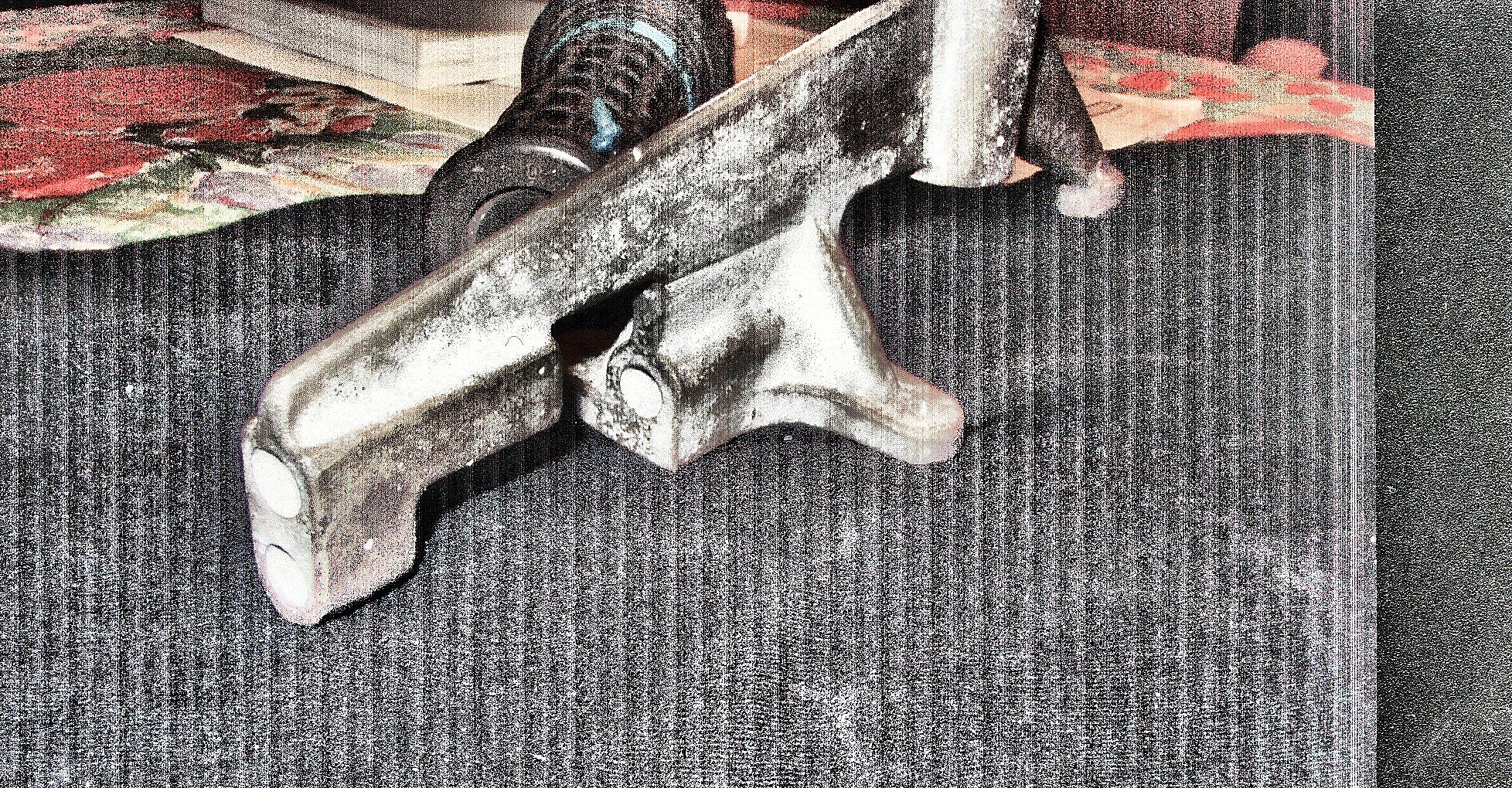
Carey said that he stored the cassette of the Baca interview with cassettes of hundreds of other interviews and forgot about it. It was only this year, Carey told me, that he became aware that Reme Baca was a key "witness" in a book co-authored by Jacques Vallee and Paola Harris. But he gave it little thought until I contacted him and implored him to search for his old interview with Baca. It was only after listening to the recording on May 8, 2023, for the first time since it was made 20 years ago, that Carey realized that the Baca story he was hearing on the tape was completely divergent from the Baca story that has since been presented to millions of people.
ANALYSIS, COMMENTARY, CONCLUSIONS
Setting aside for the moment the approximately 50,000 words that I already have written about the Trinity UFO crash story, and the reams of primary documentation that I have embedded in those articles, I say this again: Tom Carey’s recorded interview with Reme Baca by itself constitutes proof beyond a reasonable doubt that the entire Baca-Padilla tale of a UFO crash at San Antonio, New Mexico, is a hoax to its core.
Although I have written that I believe that Vallee and Harris have been very negligent and evasive on many matters pertaining to the Trinity UFO crash affair, I have never suggested or implied, nor do I believe, that either of them knowingly propagated the hoax. They were duped by two liars, acting in concert. Later a delusional fabulist, Billy Brophy, offered morphing narratives that Harris and then Vallee carefully cherry-picked for elements that they claimed constituted "corroboration." [See, however, the "Key Update" of January 29, 2025, further below.]
What Reme Baca said in his conversation with Tom Carey utterly dissolves any rational foundation for regarding Baca as anything other than an amateur fiction writer, who tried out successive and widely divergent drafts, before going public with a final version that bore only oblique resemblance to its predecessor. The UFO crash narrative found in the Vallee-Harris book, and all the extrapolations and side stories that have been spun off from the Baca-Padilla tale over the past 20 years, are built on a foundation of purely imaginary events.
Clearly, by the time he talked to Carey, Baca was already set on the idea that “before Roswell” (i.e., before July 1947) would be a good hook for a UFO-crash story. He had developed a bold claim to possession of a structured alien artifact, and a separate claim to know the location of buried alien metal– two distinct foundations for future money-raising ventures. If somebody with credentials such as Tom Carey could be snookered into adopting the story and bringing it to a wide audience, and a television special or movie thereby resulted, that would be a real jackpot for Baca and Padilla.
It must have been disappointing to Baca that Carey, who already had access to a big public audience of people interested in UFOs and UFO crash stories, did not take the bait. Based on his remarks to Carey (and other sources), Baca had found no more success with others to whom he may have pitched this rather bare-bones version of the two-boys-and-a-crashed-saucer adventure tale. But Baca did not throw in the towel! No, he did what many another short-story writer has done, when faced with a stack of rejection notes: He rolled up his sleeves and did a major rewrite, producing a story with more characters, more dialog, and more action– and also a more proximate link to the existential threat posed by nuclear weapons.
In reality, of course, we cannot know where each element in the much revised final story came from. I have written elsewhere on some of the sources from which Baca apparently borrowed elements. (See Crash Story File: The Sources of the Trinity Tale.) Jose Padilla's contributions to the final script are unknown, although it still seems plain to me that Baca was the primary author-aggregator.
Whatever the details of the process that followed the Carey-Baca conversation, it is undeniable that when Baca persuaded an old schoolmate Ben Moffett to write the details of their childhood adventure for publication in the Socorro County Mountain Mail, what Moffett heard and wrote up was a very different and more interesting story than the one that Baca had presented to Tom Carey not very many months earlier. It was still riddled with implausabilities and utterly contrived elements, in my opinion, but undeniably it was a substantial improvement on the bare-bones narrative that Baca presented to Carey.
And on this second go-around, Baca and Padilla got a bit of traction, but not a lot. Then in 2009, in a stroke of luck for Baca and Padilla, wacky UFO-crash fabulist Billy Brophy brought the story to the attention of Paola Harris, and she became its chief apostle. In 2018 Jacques Vallee threw his prestige and resources behind the story, a boon for the hoaxers that few would have predicted. By January, 2023, Reme Baca's rewritten tale was the subject of a respectful treatment in the New York Times, and had been presented to audiences of millions through various media platforms and through the Vallee-Harris book Trinity: The Best-Kept Secret (First Edition June 2021; Second Edition August 2022).
But it was never anything more than a made-up story, told and sworn to by two liars– one of whom, wily Jose, is lying still.
WHAT SHOULD JACQUES VALLEE DO NOW?
I believe that the series of Crash Story Files that I published on May 1, 2023, already contained abundant documentation fatal to the credibility of the Baca-Padilla-Harris-Vallee story of a UFO crash near San Antonio, New Mexico, in August of 1945.
However, not all agree: on May 15, 2023, Jacques Vallee issued a 5,000-word public memo that some have described as a rebuttal. Vallee’s memo consisted in large part of generalized indignation, deflections, transparent evasions regarding major exposed lies (e.g., the impossibility of involvement by the Eddie Apodaca who later became a member of the New Mexico State Police), and vertigo-inducing contortions of logic. Somewhat annoyingly, Vallee also imputed to me at least four claims that were directly contrary to what I had written on those four specific points, and then demolished his small assembly of straw men.
Surprisingly, however, Vallee also cast much shade on the credibility of Reme Baca, whom he characterized as “boastful," with "an appetite for fame," who saw the Trinity story "as a personal opportunity." Vallee even wrote, "As the primary author, I only used the recorded data originating from Reme Baca when it could be compared and verified against other statements of fact." Unfortunately, read in context, it is clear that by "other statements of fact," Vallee mostly means statements by Jose Padilla, Vallee’s still-living star “witness," who has already been caught in lie after lie.
Moreover, Vallee's downgrading of Baca's credibility is hard to reconcile with numerous previous Vallee pronouncements about the excellence of his three primary "witnesses" (e.g., this is a case "where we have the best possible witnesses" --Baca, Padilla, and Billy Brophy).
Also remarkable was Valley's bizarre attempt to distance himself from the contents of the 2011 book written by Baca and copyrighted solely by Baca (although Padilla's name was also on the cover), Born on the Edge of Ground Zero. Bizarre, since in Trinity: The Best-Kept Secret, Vallee had declared that Born on the Edge of Ground Zero to be “the primary reference to the events described here...” (Trinity: The Best-Kept Secret. First Edition, p. 317. Second Edition, p. 337.)
Strikingly, Vallee proceeded to abandon key claims set forth in Trinity: The Best-Kept Secret, about Jose Padilla’s purported extensive experience as a member of the California Highway Patrol, cited six times in Trinity. Without any explanation of how those false claims originated or could have been allowed to stand for so many years, Vallee introduced a very different (undocumented, and in some aspects highly doubtful) new history for Padilla as a "truck inspector" – and tried to slip that change past as no big deal, a mere matter of Jose misplacing some records. However, Vallee is sticking with the undocumented claim that Padilla carries a bullet in his body that he received in the line of truck-inspecting-duty. Please do not confuse this undocumented bullet-in-body with the other undocumented bullet-in-body, which came from an undocumented incident during undocumented "mop up operations" during Padilla's undocumented military service in Korea, after the end of the Korean War. [This claim, too, I have proven false, in a later article.]
Talk about "mop up operations"!
Vallee's attempt to fence himself off from the mass of wacky Billy Brophy utterances will not survive any careful scrutiny. In a 2010 interview with Paola Harris, published in the 2011 Baca book that Vallee listed as his "primary reference," Billy made highly pertinent claims that Vallee carefully filtered out, including the claim to capture of a live alien. Neither that interview, nor any of the other Billy Brophy material that I brought to light, associating Billy's long-departed pilot-father with a succession of UFO crashes, was "second- or third-hand" – it was all purportedly based on things told by the pilot to Billy, his oldest son – exactly like the stories that Vallee cherry-picked for his book. I laid this out in detail in Crash Story File: The Morphing Fantasies of Billy Brophy About His Airman Father.
And what about New Mexico State Police officer Eddie Apodaca? He is a key character in the final, published Baca-Padilla story – one of three named humans who actually enter the downed alien craft. Vallee writes, "The fact that there was someone else by that name, still deployed in France isn't relevant to the case." Not relevant to the case – as if the guy in Europe was just some random guy named Eddie Apodaca. As if that guy in Europe had not returned to New Mexico (three months after the fictional UFO crash); and as if that same Eddie Apodaca had not, five years later (August 1951) been commissioned into the small New Mexico State Police force; and as if that same Eddie Apodaca had not been assigned initially to Socorro County (where Baca and Padilla lived into their teens), where Apodaca became publicly celebrated for his rescue of 25 bus passengers held hostage by a knife-wielding criminal in 1953. Quite a coincidence! But "not relevant," says Dr. Vallee, the investigator.
[Vallee (in his May 15, 2023 public memo) wrote: "He [the real Eddie Apodaca] would have been only 21 at the time [of the fictional UFO crash], with no authority to inspect the crashed avocado." That's not my problem, Dr. Vallee, because I'm dealing with the real world, in which Eddie Apodaca was indeed age 21 on August 18, 1945, and a corporal in the Army Air Corps, and a veteran of the recently ended successful campaign to liberate Europe, still stationed in England. He was old enough to be a State Police officer, I believe, but he was not one– he was otherwise occupied. Even within your frame of reference, your comment makes no sense. William J. Brophy was also only 21 years old on the day of the mythical UFO crash, and you believe (based on the carefully filtered testimony of the mentally disordered Billy Brophy) that "lieutenant colonel" William J. Brophy (he was actually a first lieutenant at the time) was put in charge of the initial recovery of the avocado UFO. Billy also told Paola Harris in 2010 that this 21-year-old officer piloted the plane that flew the alien bodies to Wright Field.]
But set all that aside for now. The newly uncovered Tom Carey interview shows us all that less than a year before Reme Baca and Jose Padilla released their tale to the world through Ben Moffett, Baca tried hard to interest a writer who had unexcelled access to the target audience– people interested in UFOs and possible UFO crashes –an absolutely incompatible “eyewitness” story about a claimed childhood encounter between young Baca, Padilla, and a crashed alien craft.
The Tom Carey interview of Reme Baca is truly a “smoking gun” that leaves no room for reasonable doubt that the Trinity UFO crash story is pure hoax. Once this fact is widely absorbed, the Trinity UFO crash tale will continue to be embraced only by those are content to reside in the realm of the utterly irrational or delusional. I have formed the impression that Paola Harris is very comfortable in that realm, so I will be surprised if she proves capable of acknowledging the only reasonable conclusion that may be drawn from the Carey interview of Baca.
But what about Jacques Vallee?
When a scientist publishes, in good faith, data provided by others, or extrapolations based on that data, and that scientist later learns to his dismay that the data had been produced through fraud, the accepted remedy (at least in the West) is for the scientist to promptly and publicly retract all of the claims that flowed from reliance on the data now revealed to have been the product of fraud.
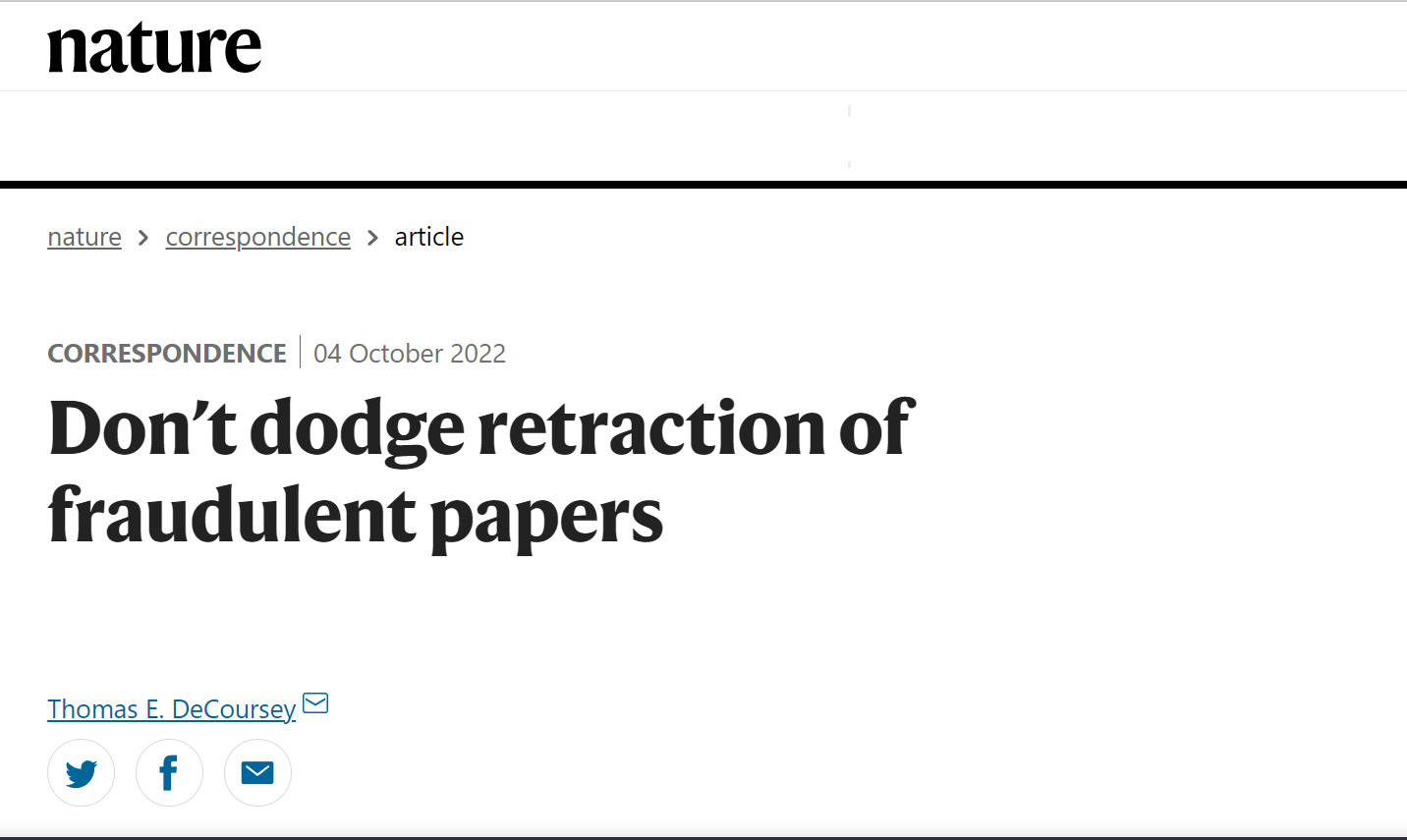
Therefore, shortly before publication of this article, I sent Jacques Vallee an email in which I encourage him to publicly and explicitly repudiate the Baca-Padilla story, and to repudiate those specific claims and extrapolations made in his book Trinity: The Best-Kept Secret that were based in whole or in part on his previous premise that the Baca-Padilla UFO crash story was a narrative of real events—a premise that is utterly unsustainable in light of the Carey “smoking gun” interview.
The text of my email to Vallee follows as regular text for ease of reading on small devices; below that, a thumbnail image of the actual email as redacted.
Subject: urging your prompt review of important new data on the origins of the Baca-Padilla story
May 20, 2023
Dear Dr. Vallee:
Later today I will publish another installment in my Crash Story Files series. It is titled "The Reme Baca Smoking-Gun Interview." It is based on a 30-minute recording of Reme Baca pitching his recollection of the ostensibly emotion-laden day ("we were scared as hell") when he and Jose Padilla encountered a crashed UFO, back when they were boys near San Antonio, New Mexico. The recording was made by a well-known writer on the Roswell Incident, Thomas C. Carey, something less than a year before the Baca-Padilla narrative was first published; that first publication occurred (as you know) in the October 30 and November 6, 2003 editions of the Mountain Mail of Socorro County, New Mexico.
Baca's purpose in contacting Carey was to interest Carey in publicizing the never-published story of the Baca-Padilla encounter. At that time Carey had recently received a spate of publicity because he had recently appeared in (and was a consultant for) a two-hour documentary on the Roswell Incident, produced by the Sci Fi Channel, under the title The Roswell Crash: Starling New Evidence. That program, heavily promoted by the Sci Fi Channel, aired on November 22, 2002, and gained a very large viewship; Baca's call to Carey came not too long after that. During the conversation, Baca gave clear indications that he and Padilla were working in concert, and that both were available for any follow ups (none occurred, for reasons I explain in my article).
I termed this interview a "smoking gun" because, in his clearly recognizable voice and very distinctive speech mannerisms (with which I am familiar from the hours and hours of old podcast interviews that I reviewed in preparing my Crash Story Files), Reme Baca narrated a UFO-crash story very different from the one that you received and embraced several years ago, as reflected in your book Trinity: The Best-Kept Secret and elsewhere.
The divergences are not minor. The personal-account story that Baca told to Carey, and the story that you received, are completely incompatible. They share an approximate locale and a few key characters, but the divergences are so extreme that they admit of only one explanation.
To summarize some high points: In the narrative offered by Baca to Carey the boys set off one summer day in 1946 (yes, 1946, not 1945), in a pickup truck (not on horseback), to visit Ground Zero (!). Quite unexpectedly (no unusual sounds or lights are reported), they come upon a big disk on the ground, with a hole in it, and glimpse some entities that look "like bugs." They return the next day with Padilla's father and a State Police officer, but somebody has covered up the craft with dirt, so the State Police officer turns and leaves without even glimpsing the craft. In subsequent days, young soldiers load debris onto "trailers." One night the two boys sneak onto one of the trailers, at an location specifically stated by Baca to not to be the crash site, and remove the artifact (bracket) that you have often held in your hands. In this narrative presented to Carey, Baca never describes any human entering the disk (which, by the way, had on the bottom what might have been big lights).
This is only a sample of the divergences, which I will explore much more thoroughly in my new article.
Carey did not take the bait, and neither had the others whom Baca had already apparently approached (among them, Stanton Friedman). Baca's lack of success with this script is not too surprising: Aside from questions of evidence, the script was too simple, too boring, and contained no poetic elements. Not easily discouraged, it appears that Baca sat down and wrote a largely new story. It still contained multiple implausible elements (in my view), but it was much improved-- more characters, more dialog, more action, more pathos, and a more proximate tie to the existential threat posed by nuclear weapons. Thus, the version that Ben Moffett heard less than a year later was substantially more engaging, and it found an audience.
Yet at bottom, the Carey recording clearly demonstrates that it was all a made-up story told by two liars. One of them, wily Jose, is lying to you still.
The surfacing of Carey's interview constitutes entirely new data on the origins of the Baca-Padilla crash story. Nobody, including Carey himself, realized such a record existed until earlier this month. Carey himself did not believe Baca's story and soon forgot about it. Carey never read your book. Carey did not realize that he had recorded a Baca narrative wildly incompatible with the Baca-Padilla story that millions have now heard, until I contacted him recently seeking old Baca utterances. Carey dug into his extensive archives and found the cassette that had rested there undisturbed for 20 years, and listened to it on May 8. Then he sent it to me.
Contrary to something you implied in your May 15, 2023 open memo, although I believe you have been very careless and evasive regarding various aspects of the Baca-Padilla affair, I have never suggested, implied or believed that you were consciously promoting a hoax. The recording of the Carey interview is entirely new data that, I submit, warrants your very close and thoughtful attention, and, I would submit, a re-set of the premises on which you have been operating.
When a scientist publishes, in good faith, data provided by others, or extrapolations based on basic data provided by others, and that scientist later learns to his dismay that the basic data had been produced through fraud, the scientist has the duty to promptly and publicly retract all of the claims that flowed from reliance on the data now revealed to have been the product of fraud.
I implore you to listen carefully to the entire 30-minute recording, which I have embedded into my new article with absolutely no edits.
Sincerely,
Douglas Dean Johnson

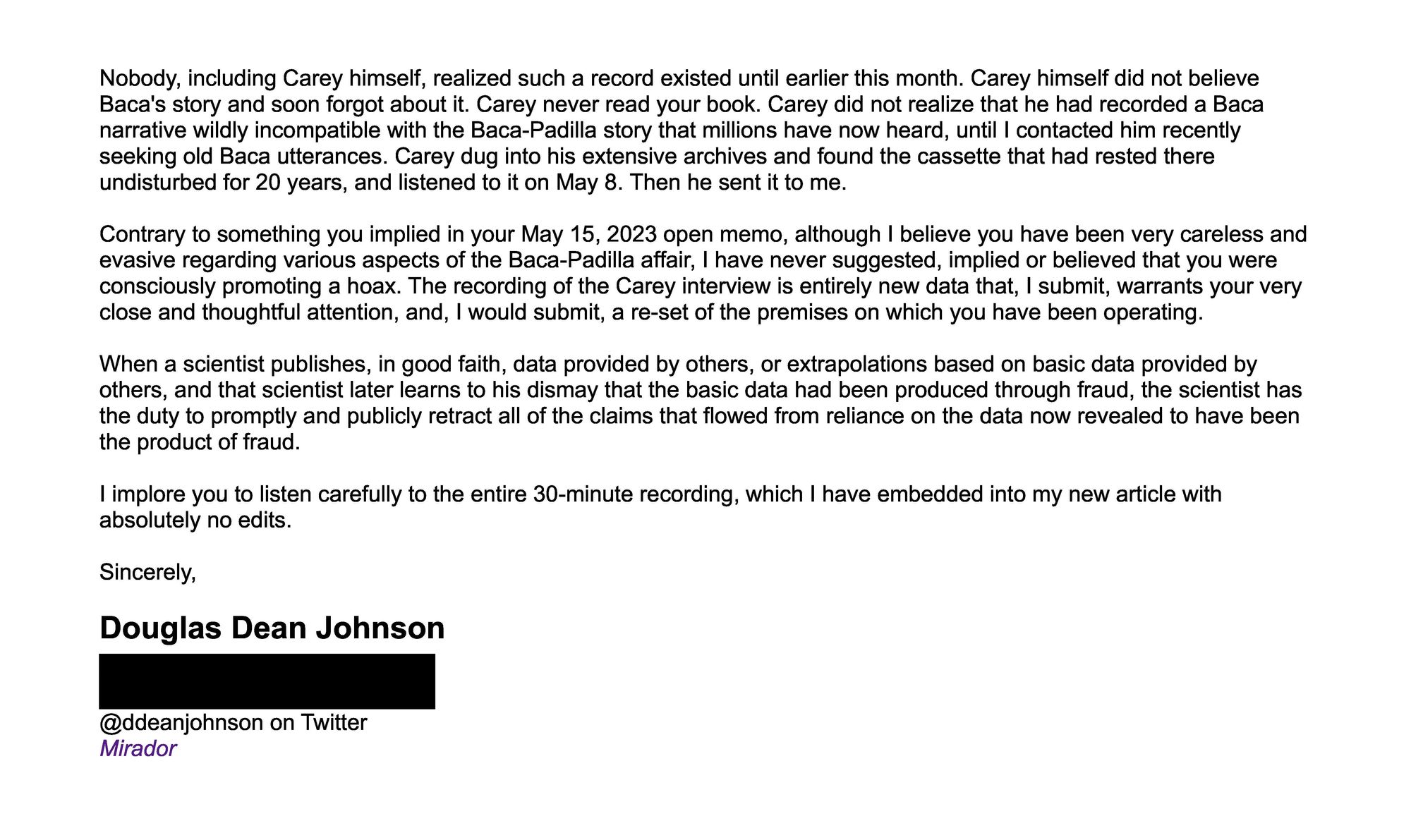
[KEY UPDATE (January 29, 2025): In the Third Edition of Trinity: The Best-Kept Secret, published in April 2024, Vallee reproduced most of his September 2023 memorandum, "A Tale of Two Urchins," under the heading "Appendix: Critical Analysis." Vallee corrected virtually none of the memo's originally inversions and other gross distortions of what I had actually written, disposing of a progression of straw men while ignoring, distorting, or brushing aside massive evidence that the entire Trinity tale is a haphazard stack of shoddy inventions.
Worse: In his treatment of the Baca-Carey interview, Vallee crossed the line into indefensible misrepresentation.
Here is the entire sum of how Vallee dealt with the article that you are reading here about the Baca-Carey recording, from page 99 of the Third Edition:
In later developments, Mr. Baca was unfairly criticized for trying to sell the rights to a fictional story based on the crash. In order to distance himself from the security issues of the actual crash, he changed the year and the place of the fictional story, just as Steven Spielberg had used real cases as background data for Close Encounters.
Either positioned as a fiction book, or as a 'treatment' for an entertainment program, it would have embellished the encounter for a general audience. Mr. Baca has been attacked by Douglas Dean Johnson for this attempt to capitalize on his childhood experience.
In fact, there is nothing wrong with a novelization of real happenings, as long as it is presented as such.
No honest listener to the Baca-Carey recording, no honest reader of the transcript, can understand the conversation as anything other than Baca presenting the 1946 crash story as the authentic childhood experience of Baca and Padilla, and defending that claim in the face of sustained questioning by Carey. Baca even described the emotions that he and Padilla had experienced during the claimed 1946 event– "we were scared as hell," and so forth.
For Vallee to now assert that there was "nothing wrong" with Baca's pitch to Carey because it was "presented as" fiction, is in my opinion objectively a demonstrable lie by Vallee. There is no excuse for Vallee not knowing what Baca actually did and said on this occasion– he could listen to Baca's very words as many times as he wished, or read the transcript – and yet, Vallee told his readers that Baca had done and said something very different from the recorded reality.
I am therefore forced to abandon my previous presumption– as expressed in the original version of The Reme Baca Smoking Gun Interview, in my May 20, 2023 email to Vallee, and many other places– that while Vallee had been negligent and evasive in dealing the deceptions of Baca and Padilla, he had operated in good faith and been duped by two liars.
That presumption, already strained by other distortions and contradictions by Vallee since May 2023, cannot survive Vallee's grotesque misrepresentation of the nature and content of Baca's audio-recorded presentation to Tom Carey.
I say again: in my opinion, Vallee has flatly lied in defense of the Baca-Padilla narrative. Vallee's gross misrepresentation will not withstand any honest review of the Baca-Carey recording or the transcript. Vallee's lie is indefensible, and those who seek to defend it will damage their own credibility as much as Vallee has already unaccountably chosen to damage his own.]
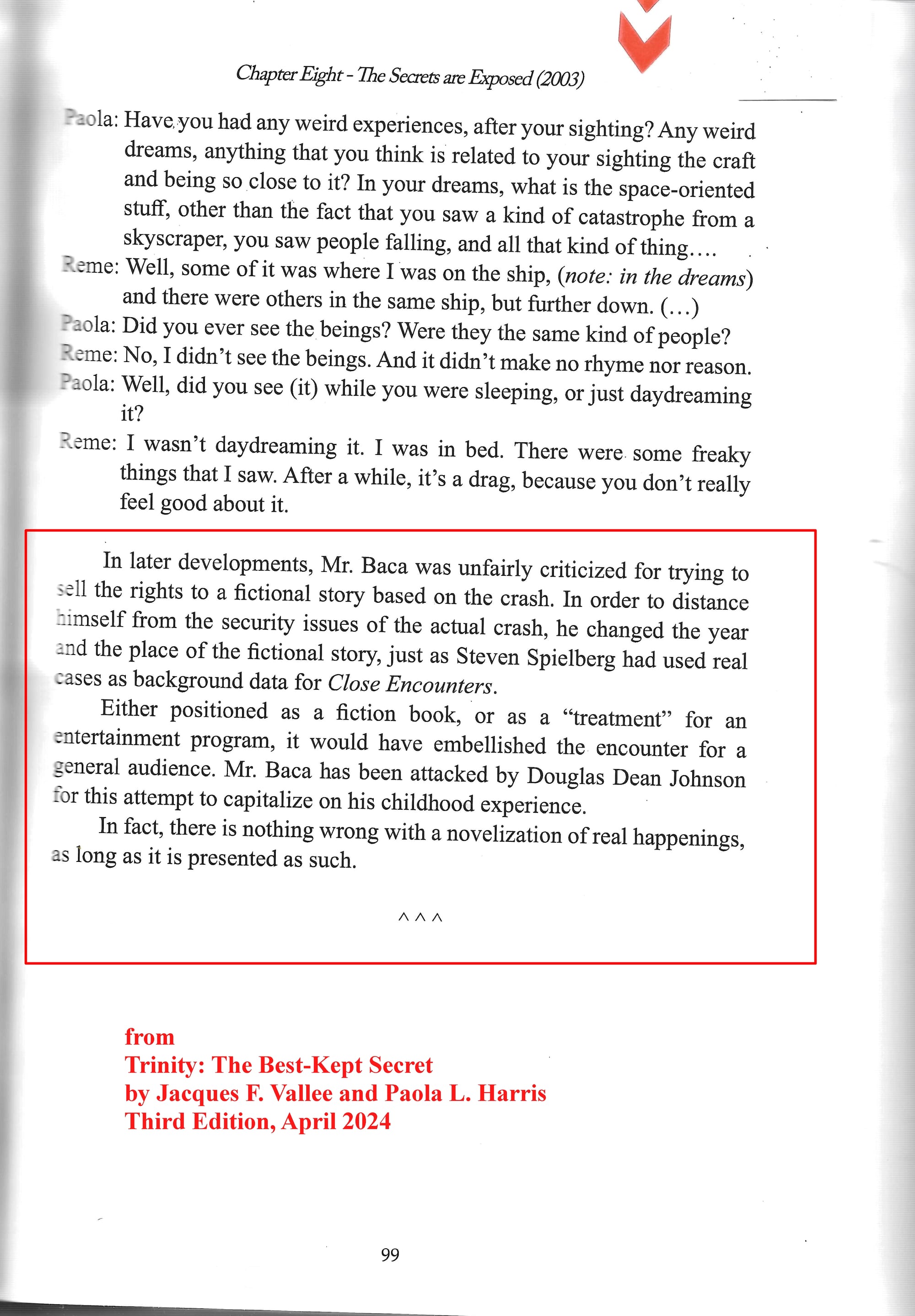
In February of 2024, after I sent Tom Carey the paragraphs from the 3rd Edition of Trinity: The Best-Kept Secret in which Jacques Vallee referred to the Carey-Baca interview, Carey strongly affirmed that Baca claimed the entire story he told to Carey was the truth, without any caveat.
WHAT ABOUT JOSE PADILLA?
I do not know whether the aging prevaricator Joseph Lopez Padilla will at some point decide to speak candidly about how he outsmarted some people who styled themselves as investigators, journalists, and scientists. Right now, I would bet against it. I spoke to Padilla by phone for seven minutes on May 9, 2023. As I was telling him about some of the mistakes that Baca had made (not the Carey interview, of which I was not yet aware), he interrupted to tell yet another impossible tale – that Officer Eddie Apodaca, and no other (“He was State Police!”) trained Jose for his first driver’s license—a license that Padilla obtained, he insisted to me, at age “eight and one-half!” Padilla was age 8-1/2 in the spring of 1945, when Apodaca’s Army Air Corps unit, the 370th Fighter Squadron, was in Europe. When I pointed this out to Padilla, his response was, “Excuse me, sir, I am going to have to hang up now and call my manager.” And he did hang up.
Of course, in the real world, New Mexico did not award driving licenses to 8-year-olds, even 8-year-olds who were allowed to drive vehicles on private ranch property.
But Jose Padilla has a “manager”—who knew? Do you think he has a book deal in the works?
********
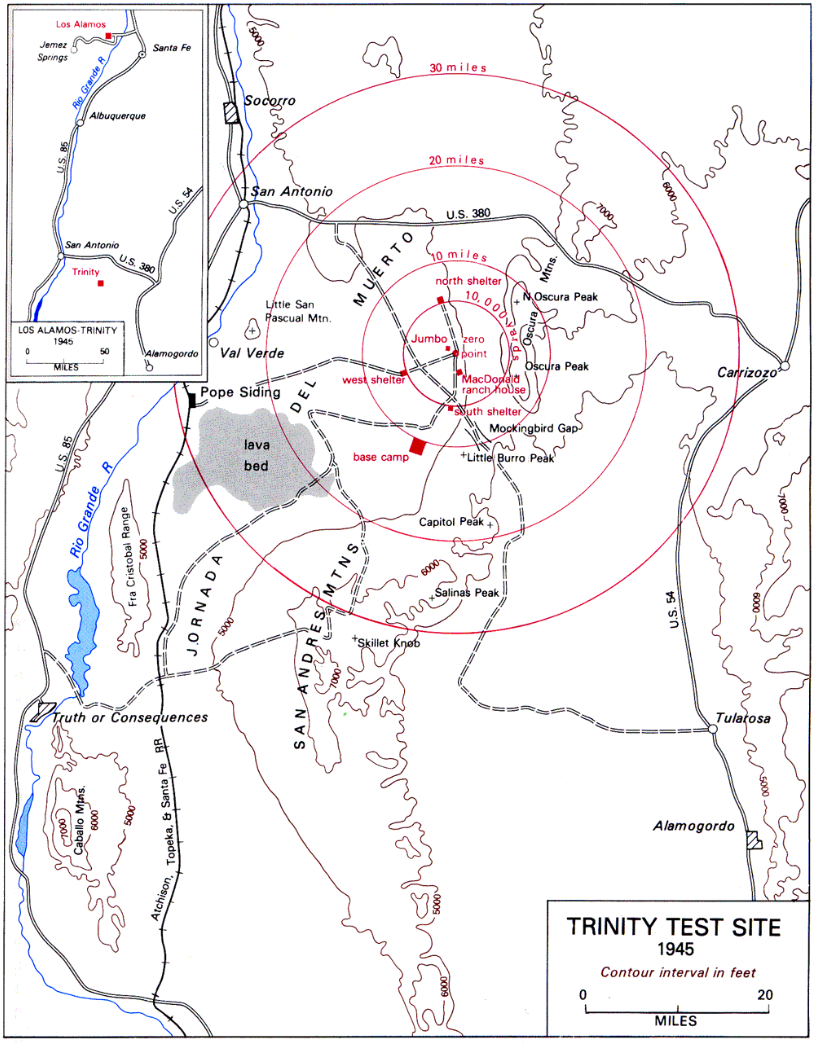
ADDENDUM A: HOW THE TOM CAREY INTERVIEW OF REME BACA CAME ABOUT, AND HOW I LEARNED OF IT
Thomas J. Carey is a well-known as an author of articles about, and a frequent contributor to books and television programs about, the Roswell Incident of 1947 and related subsequent events. For many years Carey has worked in association with Donald R. Schmitt, who is also the author or co-author of many Roswell-related books and articles.
As I reported in Crash Story File: The Sources of the Trinity Tale, in 2021 Schmitt wrote an essay sharply critical of the Vallee-Harris book Trinity: The Best-Kept Secret. In that essay, Schmitt related that he had given a talk about the Roswell Incident in Ventura County, California, in 1997 [later corrected by Schmitt to 1995; see endnote no. 6 below], after which one of the attendees, Reme Baca, approached him with a story about involvement with a UFO crash in 1947. (Baca at that time resided in Ventura County, where he made his living as an insurance salesman and was involved with the local MUFON chapter.) Schmitt wrote down Baca’s contact information and later passed on the tip to his associate, Tom Carey. In his 2021 essay, Schmitt indicated that Carey eventually spoke with Baca, and that Baca had seemed mostly interested in learning how he could make money on his story. After reading Schmitt’s 2021 essay, I reached out to Carey to inquire about his interactions with Baca. This led Carey to dig out the cassette recording of the interview, forgotten for 20 years.
Carey told me that in the years immediately after receiving that information from Schmitt, he tried several times to reach Baca for the purpose of conducting an interview, but was unsuccessful. Carey did not know that in or about 2000, the Baca family had moved out of California, to Washington State; Carey was working with outdated contact information. There the matter rested until Baca on his own initiative called Carey (sometime after November 22, 2002 but no later than mid-2003), as part of an effort by Baca to engage the interest of some prominent UFO writer-researcher in his childhood adventure story.
I express my deep appreciation to Tom Carey for asking the right questions and for preserving this document; for the trouble he went to locate the cassette; for lending it to me; and for his assistance in reconstructing the sequence of events. However, I alone am responsible for all of the summaries, characterizations, and opinions found in this article; Mr. Carey is responsible for nothing except the direct quotations attributed to him by name.
Tom Carey has provided me with a vita that I have embedded below. I can make no personal recommendations regarding Roswell-related materials. I have only a smattering of knowledge of the issues surrounding the Roswell Incident. I do not believe I have ever expressed any public opinion about what occurred near Roswell in 1947. Therefore, there is no basis for Jacques Vallee’s vague insinuation, in his May 15, 2023 “rebuttal” memo, that my critiques of the Baca-Padilla story may somehow reflect the interests of persons wishing to protect a Roswell-associated "highly profitable cottage industry of Alien entertainment."
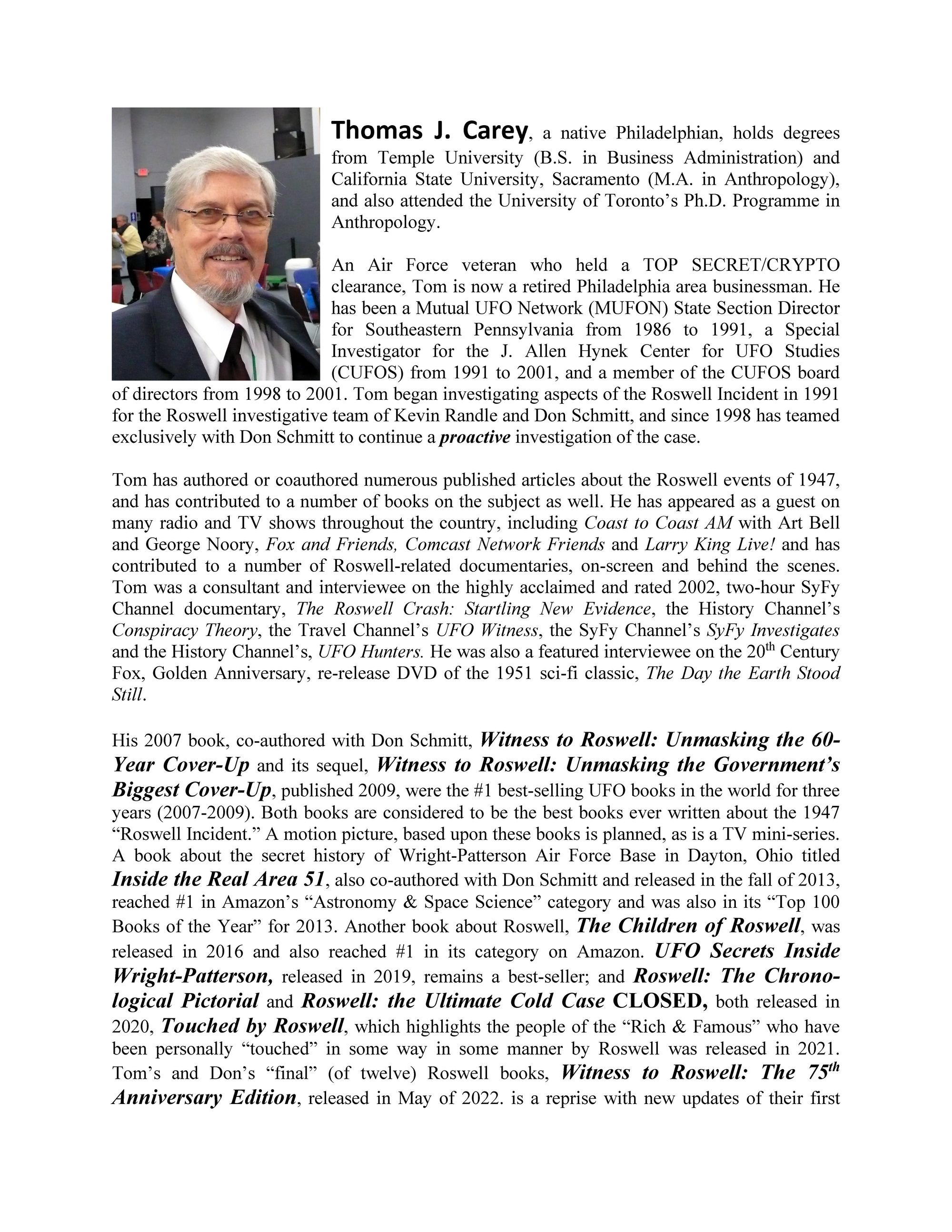
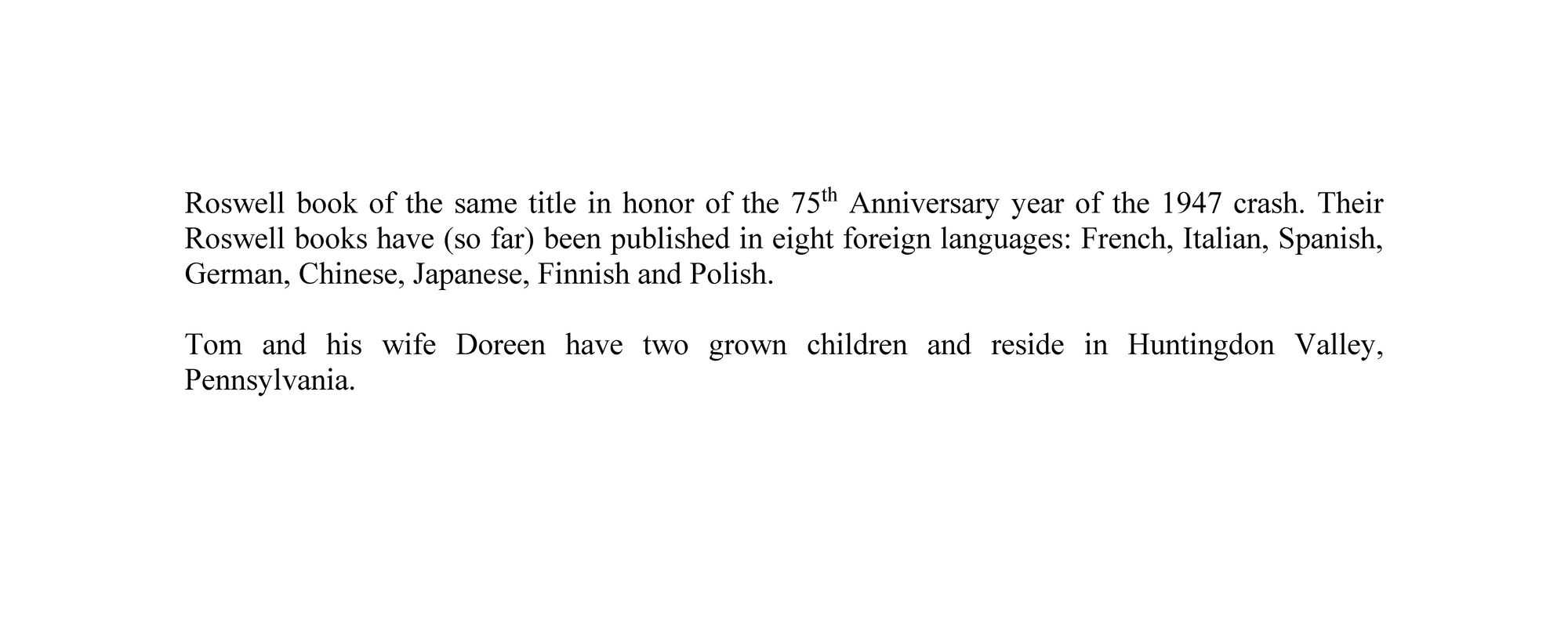
ADDENDUM B: TWO UFO-THEMED SONGS BY REME BACA
Following the recorded telephone conversation that is the main subject of this article, Reme Baca mailed Carey a cassette containing two songs sung by Baca. One song is in English, the other in Spanish. There can be little doubt that the English song, at least, was also written by Baca, although any explanatory material that accompanied the cassette has been lost. I had these recordings professionally digitized and noise levels reduced; the audio files of the two songs are embedded below. If you have any trouble playing or downloading the embedded files below, you can also download the song-in-English from this link, and the song-in-Spanish from this link.
In order to make the words clearer, Drew Williamson produced an audio file that filtered out most of the music, which allowed him to improve on the flawed transcript that I had originally posted. The vocal-only audio file, and the perfected transcript of the lyrics, are embedded below. The vocal-only audio file can also be downloaded from this link.
From my perspective, the most interesting aspects of the little story told in "Visitors" is that Baca and others are “incensed” at the military, which has led them astray in the past (given them "wooden nickels" and phony bridge deals); that Baca does not wish to discuss his alien metal with the military; and that Baca will instead put the alien material “on the auction block.” Baca did indeed later put his fake alien artifact on the auction block, in a fashion, but apparently nobody was willing to meet his price of $250,000.
Below, I have embedded a cross-sourced transcript and translation of Reme Baca's song-in-Spanish, in both Microsoft Word and PDF. There are still some phrases that are unintelligible.
My gmail address is my full name, with periods on each side of my middle name. I have been advised that the address will still work if you omit the periods, but why would you want to do such a thing?
LIST OF SUBSTANTIVE CHANGES OR UPDATES SINCE THE ORIGINAL PUBLICATION OF THIS ARTICLE ON MAY 20, 2023:
(1) On May 31, 2023, I made several corrections to reflect that Eddie Apodaca, a radio operator with the 370th Fighter Squadron of the Army Air Corps, was stationed in England (not Germany) in the spring of 1945 (when Jose Padilla got his first driver's license under Apodaca's guidance, in the implausible story Padilla told me on May 9, 2023), and also in August 1945 when the mythical UFO crash is said to have occurred near San Antonio, New Mexico. The squadron's planes fought over continental Europe, including Germany, up until the German surrender on May 7, 1945, but the squadron's base was always in southeastern England, and never in Fritzlar, Germany, as I mistakenly wrote. This correction regarding Eddie Apodaca's base location during this period is of no consequence with respect to the falsity of the claims about his activities propagated by Padilla and Reme Baca.
(2) I had written above that Billy Brophy told Paola Harris that his father (William J. Brophy) had piloted the plane that carried the alien cadavers to Wright Field "in an interview printed in the same book that you [Jacques Vallee] said was the 'primary reference' for your book..." This was a reference to a 2010 interview by Harris of Brophy, the transcript of which was published in Reme Baca's Born on the Edge of Ground Zero (2011), which Vallee-Harris said was their "primary reference" for the narrative contained in Trinity: The Best-Kept Secret. In that interview (reproduced in total here), Billy did talk about his father's supposed role in the crash cleanup, the recovery of alien cadavers, and the cadavers being flown to Wright– but he did not mention, in that interview, that his father flew the plane. However, Billy told Harris that his father flew the cadaver plane during the same general time frame, because she mentioned it during her December 1, 2010 appearance on Coast to Coast AM, as I quoted accurately in this article. I have tweaked the passage above to accurately reflect where Harris referred to Billy Brophy's claim that William J. Brophy, then only age 21, flew the plane carrying the alien bodies.
(3) On May 22, 2023, I embedded a vocals-only audio file of Reme Baca's song-in-English, produced by Drew Williamson, and also a perfected PDF transcript of the lyrics of that song, based on Mr. Williamson's vocal-only audio file. I have also embedded in both Microsoft Word and PDF a crowd-sourced transcript and translation of Reme Baca's song-in-Spanish (there are still a few phrases that are unintelligible).
(4) On May 22, 2023, I added a notation that a Showtime movie of which Reme Baca spoke during his conversation with Carey, Roswell: The UFO Cover Up, first aired on July 31, 1994. Years later, Reme Baca and his wife told Paola Harris that during July 1994 they had watched a UFO "big as a football field" pass over their heads one evening in Tacoma, Washington, a claim that I examined in Crash Story File: The Baca UFO Sighting of July, 1994.
(5) On May 26, 2003, corrected typo: A sentence that read, "By January, 2021, Reme Baca's rewritten tale was the subject of a respectful treatment in the New York Times..." corrected to read "By January, 2023..."
(6) May 26, 2023: I inserted information from an email in which Donald Schmitt told me that after further review of his records, he now believes that his conversation with Reme Baca occurred following a summer, 1995 Schmitt lecture in Ventura County, California (rather than summer, 1997, as stated originally here).
(7) June 9, 2023: After further review of the Carey-Baca transcript, I made a small change to make it clear that Baca was not suggesting that there was anything extraordinary about the Christmas tree decorations used in his childhood. Rather, he was claiming that at the crash site, they picked up some material that in appearance resembled a Christmas tree decoration called "angel hair." (At timestamp 7:46: "there's material on the outside. It's what we called, because I didn't know anything to compare it with, angel hair. We used to use that on Christmas trees....so we had picked up some of that.") There was indeed an elongated material commonly sold as Christmas tree decoration in the 1950s, called angel hair, made of fiberglass or spun glass. I believe that Baca here was trying to create another tie-in to claims found in some literature about the 1947 Roswell Incident, asserting that a kind of fiber-optic cable was found at that crash site.
(8) June 10, 2023: The article above refers several times to a public memorandum by Jacques Vallee, dated May 15, 2023, which criticized various aspects of my original suite of articles about the Trinity UFO-crash hoax. (My original batch of articles had been published on May 1, 2023.) As originally published, the article above linked directly to the Vallee memo on the website of Paola Harris, co-author of Trinity: The Best-Kept Secret. However, on or around June 8, 2023, the Vallee memo disappeared from the Harris website, without explanation. Therefore, I have revised the article above to utilize links to a PDF version of the Vallee memorandum, which I had printed from the Harris website on May 17, 2023.
(9) September 26, 2023: I added a quote from a presentation given by Paola Harris on September 16, 2023, in which she said, "Reme Bacca was pretty greedy. He wanted $250,000 for the piece, and he wanted $250,000 for the story," et cetera.
(10) November 4, 2023: I added a notation that in a "declaration" published September 23, 2023, Jacques Vallee conceded that the UFO-crash eyewitness story told by Reme Baca to Tom Carey was "fiction," but (bizarrely) Vallee continued to defend as real the UFO-crash story told by Baca and Jose Padilla to Ben Moffett and others at later dates. However, on January 29, 2025, I removed this notation and inserted a "Key Update" based on Vallee's treatment of the Baca-Carey matter in the 3rd Edition of Trinity: The Best-Kept Secret, published in April 2024. The "Key Update" is described in item no. 12 on this list of revisions.
(11) December 30, 2023: I corrected the date of Eddie Apodaca's commission as a New Mexico State Police (NMSP) officer from January 1951 to August 1951. Apodaca did enter the NMSP training program in January, but his graduation and commission was in August, as I had accurately reported in my article about Apodaca. Also, I had written that pilot William J. Brophy was "a mere lieutenant" in August 1945; I have revised this to read "a first lieutenant" based on recently obtained military records. From the Tom Carey interview, I added Baca's statement about the reason that the boys ostensibly wished to visit Ground Zero, "We wanted some of that green stuff," apparently referring to trinitite, a green glassy substance produced by the atomic blast.
(12) January 29, 2025: I added a "Key Update," which appears in boldface font in the section headed "What Should Jacques Vallee Do Now?" This update includes the entire text of Vallee's deceptive description of the Baca-Padilla interview, found on page 99 of the Third Edition of Trinity: The Best-Kept Secret, published in April 2024, and offers my assessment regarding the significance of this blatant misrepresentation by Vallee.
(13) January 29, 2025: I made several changes to expand slightly on some of the points of divergence between the 2002 Baca story of a 1946 UFO crash and the 2003 Baca-Padilla story of a 1945 UFO crash, but without substantive revisions.
(14) March 12, 2025: I added a paragraph regarding Tom Carey's strong affirmation, in February 2025, that in 2002 Reme Baca presented his UFO-crash story to Carey as pure truth, without any caveat.
